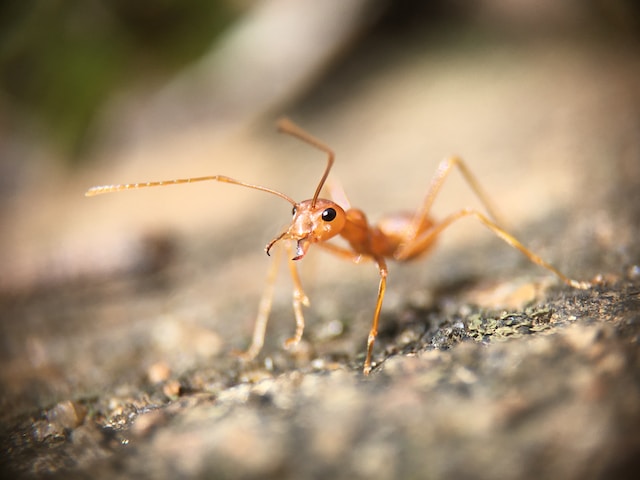Ants are a common nuisance for homeowners and businesses alike. These insects can invade our spaces and cause significant damage to our structures, food, and belongings. To effectively control ants, it’s important to understand their anatomy and behavior.
In this blog, we’ll dive deep into the world of these insects and explore the different ant body parts that make them tick. By understanding ant anatomy, you’ll be better equipped to identify different species, develop effective pest control strategies, and prevent negative interactions with these tiny but formidable foes.
So grab your magnifying glass, and let’s get started!
The Star of the Show: An Ant’s Head
An ant’s head is a complex and highly specialized structure responsible for sensory and feeding functions. Of course, the head is the most anterior (or front-facing) portion of the ant’s body, attached to its thorax by a narrow neck-like structure called the petiole.
Large compound eyes are perhaps the most remarkable and prominent feature of an ant’s head. These peepers have multiple small lenses with a wide field of vision, capable of detecting movement and changes in light sensitivity.
In addition to their eyes, ants also have a pair of long, slender antennae on their head for detecting chemicals and communication. These antennae are covered with tiny hairs and are extremely sensitive to touch, taste, and smell.
Don’t forget those sharp pinchers, either! The powerful mandibles are utilized for grasping food, fighting with other ants, and defending the colony. The mandibles are made of chitin, a strong and durable material, and can exert tremendous force.

In short, an ant’s head may seem small, but it’s a powerhouse of sensory perception and feeding prowess. Just steer clear of those powerful mandibles!
Understanding an Ant’s Thorax
Ants are small but mighty creatures, and their thorax is a key part of what makes them so unique. This specialized body segment sits between the head and abdomen and is home to many vital structures that allow ants to perform impressive feats.
For starters, an ant’s thorax is where you’ll find its legs – jointed and covered in tiny hairs and sensory structures needed to detect environmental changes. But the thorax is also home to the ant’s wings (if they have them) and houses portions of the respiratory, digestive, and reproductive systems with the abdomen.
Unlike other insects, the distinctions between an ant’s thorax and abdomen aren’t abundantly clear. In fact, these two appendages are slightly fused together, meaning most of these functions are shared between the two body parts.
Ant Body Parts: The Abdomen
The ant abdomen may not be the most glamorous of the ant body parts, but it is certainly one of the most important. This segment of an ant’s body contains vital functions that help keep the colony running like clockwork.
One of the most impressive aspects of the ant abdomen is its role in reproduction. A queen ant’s abdomen enlarges significantly to make room for an endless supply of eggs, enabling the colony to grow and expand.
But the abdomen is not just for reproduction – it’s also where the digestive and excretory systems are located. Inside the abdomen, ants have a complex network of organs and tissues that break down food and eliminate waste products.
Don’t forget about communication! Through the production of pheromones, ants can convey all sorts of messages to one another – from the location of food to the presence of danger. The glands that produce these pheromones are located in the abdomen, making it an essential hub for communication within the colony.
Ant Stingers
What’s one of the most painful ant body parts? Let’s take a look at the stinger!
When it comes to defending their colonies, ants don’t mess around. Many ant species have evolved a formidable weapon to keep predators at bay: their stinger. These sharp, barbed structures are located at the end of the ant’s abdomen and can pack a painful punch.
When an ant stings, it’s not just a simple poke. The barbs on the stinger easily penetrate the skin, making it difficult to remove. Plus, the ant injects venom into the wound, which can cause a range of symptoms from mild irritation to severe allergic reactions.
Despite the potential dangers of ant stings, they’re a critical adaptation that helps ants protect their colonies from all sorts of threats. Whether they’re fending off hungry birds or battling other ant colonies for resources, the stinger is a key part of the ant’s arsenal.
Why Do Ant Body Parts Matter to a Pest Professional?
Knowing the different body parts of ants enables pest control professionals to distinguish the specific ant species they are dealing with. This understanding is crucial because each species has unique behaviors, habitats, and food preferences that impact how they should be managed.
Don’t deal with dangerous pests like ants alone! proof. can help eliminate pesky insects in your home or yard. Contact us today to keep your family safe!

